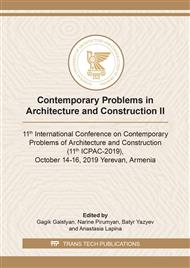p.58
p.63
p.68
p.73
p.81
p.89
p.94
p.100
p.106
On the Interaction at Anti-Flat Deformation of Stress Concentrators of the Type of Cracks and Stringers with Regard to the Layer Manufactured from Miscellaneous Materials
Abstract:
In this paper, we consider the problem of determining the basic characteristics of the stress state of a composite in the form of a piecewise homogeneous elastic layer reinforced along its extreme edges by stringers of finite lengths and containing a collinear system of an arbitrary number of cracks at the junction line of heterogeneous materials. It is assumed that stringers along their longitudinal edges are loaded with tangential forces, and along their vertical edges - with horizontal concentrated forces. In addition, the cracks are laden with distributed tangential forces of different intensities. The case is also considered when the lower edge of the composite layer is free from the stringer and rigidly clamped. It is believed that under the action of these loads, the composite layer in the direction of one of the coordinate axes is in conditions of anti-flat deformation (longitudinal shift). Using the Fourier integral transform, the solution of the problem is reduced to solving a system of singular integral equations (SIE) of three equations. The solution of this system is obtained by a well-known numerical-analytical method for solving the SIE using Gauss quadrature formulas by the use of the Chebyshev nodes. As a result, the solution of the original system of SIE is reduced to the solution of the system of systems of linear algebraic equations (SLAE). Various special cases are considered, when the defining SIE and the SLAE of the task are greatly simplified, which will make it possible to carry out a detailed numerical analysis and identify patterns of change in the characteristics of the tasks.
Info:
Periodical:
Pages:
81-88
Citation:
Online since:
December 2019
Authors:
Price:
Сopyright:
© 2020 Trans Tech Publications Ltd. All Rights Reserved
Share:
Citation:


